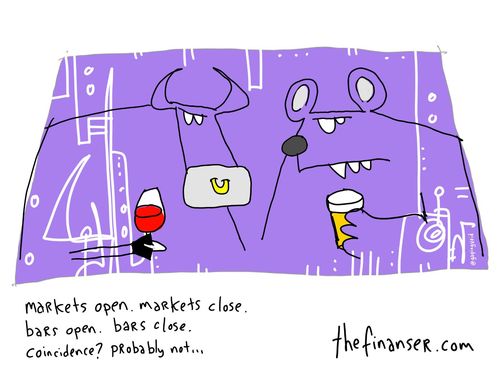This is a guest post by Financial Services Club speaker Laurens Vis, Managing Director of KAS Bank.
The stakes are high. Directive 2008/7/EC, the Council Directive on a common system of
Financial Transaction Tax (FTT), is testing the resilience
of
EU Member States and Markets alike - so far it is turning out to become less common than the EU was hoping for. Then again, none of the existing financial transactions taxes which are currently in operation on planet earth
are
equal (although some are more equal than
others and they all
share the nasty habit of outstaying their welcome once introduced).
The history of the FTT concept can be traced back to the 1600s. Since its inception,
in different countries, under different names and in various shapes and forms, it has never
been a levy on financial institutions, but rather on taxable transactions as defined. The Dutch apparently started it all in 1624 by setting a competition
to create a new tax levy
and,
once implemented in Holland,
it was then brought to Britain by William of Orange.
The
London Stock Exchange implemented an FTT in 1694 as a Stamp Duty payable by the buyer of shares. The tax, which was only meant to be in place for a couple of years in
order to finance a war against France, is still around to this very day and, when from early 1800 the stamp duty transitioned from a flat tax into an ad valorem tax, a new ‘runner’
for the
taxman
was
born; today
representing on
average
0.2% of
Gross Domestic Product in the UK
alone, it generates more revenue than the sum
of
inheritance and capital gains tax combined and is much easier to collect.
European Politicians contently bask, although with an undertone of uncertainty,
in FTT
revenue estimates of at least €70bn per annum if the tax rate were 0.1% on the gross proceeds of equity transactions. What more do they want?
What they want is a FTT that produces all of the above
and curbs unwanted behaviour in financial circles. The initiator of this thought was none other than John Maynard Keynes who, after the Great Depression, suggested the levy of a small FTT on the deals
taking place on
Wall Street to
curb
‘excessive speculation by uninformed financial
traders’, although, years later, better informed economic historians
have
found that the author of the ‘General Theory on Employment, Interest and Money’ also had his own
motives to mitigate the predominance of speculation over enterprise - his personal assets had been nearly wiped out in the Stock Market Crash which he failed to foresee.
Nethertheless, the Transaction Tax die
was cast. When the monetary world nearly keeled
over after the abolition of the Bretton Woods
System and a Tsunami of funds started to move across Foreign Currency Exchanges,
James Tobin (a disciple of Keynes) provided two solutions.
The first , which Europeans know only too well by now, was the move towards a ‘common currency, monetary
and
fiscal policy, and full
economic integration’
and
the second, was increased segmentation
between nations and currencies, allowing Central
Banks
and Governments
to
tailor their policies for the benefit of their own economies.
Tobin soon came to realise, the first option was, in this day and age, hardly politically
viable and he lived to regret recommending the second, but he was still prepared to throw a spanner in the ‘Money Market’ works, each and every
time trades from ‘currency and coin to equity securities’ were conducted.
The
Tobin tax was born but proved
somewhat short-lived in its’ academic popularity.
In 2002, the German Professor Paul Bernd Spahn came to the conclusion
that
the Tobin
tax
was not fit for purpose ‘and should be laid aside for good’.
He drily observed that it is simply not possible to distinguish
between normal liquidity
trading and speculative noise trading. FTT might be fit
for tax purposes but not when the Markets are in the grip of abnormal trading - only a prohibitive exchange surcharge, the
Spahn Tax, could stem the attacks of the speculators.
Purpose
The initial EU Council Directive on a common system of financial
tax
was launched in
response to the major role the financial sector played in the cause of the financial crisis,
the
need to repay for the repair of the damage caused, but also to provide
a common approach for the internal European market and to complete
the
EU Regulatory framework for safer (!) financial services by addressing risky behaviour.
The aim of the Proposal? To avoid uncoordinated national tax measures, to ensure a fair
contribution from financial institutions towards the cost of the crisis, to secure a level ‘taxation’ playing field with other sectors in the economy, to discourage transactions which go against the efficiency of the financial market and to create a revenue
stream in order to replace national contributions to the EU Budget. Last but not least, it aims to
substantially contribute to the international debate on financial sector taxation and to develop an FTT at global level. As the EU Council qualifies its own Directive:
‘a
fine demonstration of how an effective FTT can be designed and implemented, while generating significant revenue’.
This is somewhat at odds with the IMF’s (Staff of the IMF 2010) response to a request from the G-20 leaders as to how the financial sector can ‘best’ support the repair of the workings of the banking system. The IMF report reads that an FTT undeniably raises revenue (providing avoidance is addressed), but is not well suited to what the G-20 leaders are looking to achieve in order to curb excessive risk-taking on a ‘heads I win,
tails you lose’ basis.
At the heart of this is the notion that the FTT targets the gross proceeds of transactions, while the Financial Activities Tax (FAT) (as ‘proposed’ by the IMF) targets the net
proceeds that financial firms generate through their business
activities (thus resembling
other VAT-paying businesses and introducing the sought after level playing field ).
To make a long ‘FTT versus FAT’ story short,
the FAT focus is on the actual tax-
discouragement of risky investments and undesirable market behaviour, whereas the FTT
primarily
passes on a large part of the ‘tails you lose’ burden to the users of financial
services (institutional and retail investors alike).
Reception
A Directive is a legislative
act of the European Union which requires member states to
achieve particular results, whilst allowing them the choice of method as to how to realise them. Directives are addressed to
all member states, and are to be implemented correctly (or transposed
if
the law of a member state is already compliant with the new legislation). If National legislation fails to do so, the European Commission initiates legal
action via the European Court of Justice (there are 2900 such cases open, of which 740 on the initiative of the Commission itself). It was a tough-call to drive the Europe-wide tax through in the first place, and it created a divide amongst member
states. The enhanced cooperation procedure, introduced by The treaty of Amsterdam (Article 20
TEU), was called into action for the purpose of
advanced integration between
the member states (at least 9 of
them) wishing to participate.
Thus far, 11 member states have signed in, 3 of them (Belgium, France and Greece) with a FTT of sorts in place, leaving,
amongst others the UK (with its own Stamp Duty) and
The
Netherlands (FTT inventors in 1624 but, after their initial ‘strong’ interest in the levy, the Dutch have now withdrawn their support - the proposals deemed to be ‘disastrous’
for
pension funds, ‘undesirable’
for economic growth and ‘doubtful’ for the discouragement of disruptive market behaviour) in the other camp.
The Directive has received a mixed reception. From the ethical areas of the Public
domain, where its’ representatives
are
possibly less burdened with the intricacies of the financial markets, none other than the Pope (before he resigned, that is) expressed
a strong interest in the introduction
of
the Tax and the Archbishop
of
Canterbury has also put his full weight behind its introduction.
And the Financial
Sector
itself?
From the World Bank to the European Central Bank, from the Association for Financial Markets in Europe (AFME) to The European Federation for Retirement Provisions (EFAMA), the collective conclusions are:
- FTT will not generate significant revenue (with estimates for the ‘enhanced’ group of EU participants already half of the initial outlook) and disproportionally paid by ‘innocent by-standers’ such as low risk fund managers, retirement savers and income earners in Society
- FTT will not stabilize markets if need be, but will increase volatility overall
- FTT will not increase GDP growth, but will increase unemployment
- FTT will not
hold bankers accountable as
it
is not
a
direct taxation nor a regulation
Work in progress
FTT targets ‘everything that moves’. It concerns all secondary financial transactions
(from shares to derivatives) by financial institutions on the buy-side and on the sell-side (from organised markets to pension funds) in the participating EU Member States in question. FTT rates may not be lower than 0.1 % for assets and 0.01% for derivatives.
Therefore, the EU’s taxation commissioner calls FTT a fair tax and a milestone in European and global tax history ‘answering the long-time calls of their citizens’. So far,
so good and it all has to start across the board in 2014.
France is already there, it seems, having introduced a French version of FTT of 0.2% on the purchase of shares in French quoted companies as of August 2012, resulting in an estimated 0.5 bn
EUR worth of
revenues in 2013.
Italy is following suit with a rather more complicated lay of the ‘FTT’ land, leaving room for ‘likely interpretation of amendments
and
further upcoming Ministerial Decrees’. The Italian FTT is to be applied in
different ways to
share transactions (0.1%), share transactions in companies with a market value of below 0.5 bn EUR (0%), new shares
from new issuances or bond conversions (0%). More strikingly, the territoriality rule is
exclusively based on the residence
of the issuer (instead of the ‘EU’ residence of the institutions involved in the transaction) and on the net proceeds of daily transactions by the same institution (instead of the EU gross consideration
of
each and every
transaction,
whether closed-out intraday or not). The Italian authorities have kept the
best news to the last for their
financial
sector: the Italian Style FTT does not apply to
market-making activities, corporate brokerage and compulsory pension schemes.
There goes the enhanced EU neighbourhood!
And so, while EU politicians are busy suggesting good deed initiatives to be paid for using the freshly collected tax monies, and the French President himself is dreamily thinking of putting a large chunk of it to the benefit of ‘international developments’, the FTT, as a
harmonized EU Tax Measure and Cornerstone of the Common Market, is slowly
sinking below
the EU
horizon.
The FTT will,
in
all likelihood, not
be collected by Europeans for Europeans, but at national level on the basis of
11 or more national taxes.
The common market is still a long way from home.
Laurens Vis, Managing Director, KAS BANK UK
Laurens Vis is the Managing Director of KAS BANK UK, an independent European
specialist in securities services. In addition to steering KAS BANK’s strategy in the UK
market, Laurens holds overall responsibility for
UK sales and acquisition, relationship management, and product and market development.
Further information about KAS BANK NV is available at www.kasbank.com
Chris M Skinner
Chris Skinner is best known as an independent commentator on the financial markets through his blog, TheFinanser.com, as author of the bestselling book Digital Bank, and Chair of the European networking forum the Financial Services Club. He has been voted one of the most influential people in banking by The Financial Brand (as well as one of the best blogs), a FinTech Titan (Next Bank), one of the Fintech Leaders you need to follow (City AM, Deluxe and Jax Finance), as well as one of the Top 40 most influential people in financial technology by the Wall Street Journal's Financial News. To learn more click here...




















